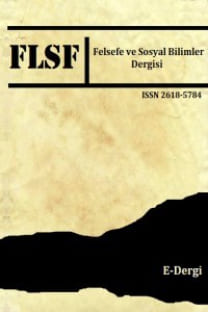ARISTOTELES’İN PARADEIGMA ANLAYIŞI VE CICERO’NUN RETORİKTEKİ KULLANIMINA ETKİSİ
Cicero, Aristoteles, Retorik, De Inventione, Inductio, Paradeigma παράδειγμα , Epagōgē ἐπαγωγή , Deductio
Aristotle’s Paradeigma Notion and it’s Influence On Cicero’s Usage in Rhetoric
Cicero, Aristotle, Rhetoric, De Inventione, Inductio, Paradeigma παράδειγμα , Epagōgē ἐπαγωγή , Deductio.,
___
- Arslan, A. (2007). İlkçağ Felsefe Tarihi 3: Aristoteles. İstanbul: İstanbul Bilgi Üniversitesi. Arist. = Arıstoteles
- _____An. Pr.= Analytikon Proterōn. (2002). The Categories, On Interpretation, Prior Analytics. Çev. Hugh Trendennick Cambridge (Ma): Harvard University (The Loeb Classical Library).
- _____An. Post.= Analytikon Hysterōn. (1960). Posterior Analytics, Topica Çev. Hugh Trendennick. Cambridge (Ma): Harvard University, (The Loeb Classical Library).
- _____(1960). Aristotle’s Prior and Posterior Analytics: A Revised Text With Introduction And Commentary. Çev. Ross. W.D. London: Oxford University.
- _____Rh.= Peri Rhētorikēs. (2006). The “Art” Of Rhetoric. Çev. John Henry Freese, Cambridge (Ma): Harvard University, (The Loeb Classical Library).
- _____Top.= Topikōn. (2002). The Categories, on Interpretation, Prior Analytics. Çev. Hugh Trendennick Cambridge (Ma): Harvard University, (The Loeb Classical Library).
- Benoit, W. L. (1987) “On Aristotle’s Example.” Philosophy&Rhetoric 20/4: 261-267. Cic. = Cıcero
- _____Inv. Rhet.= De Inventione. (1993). De Inventione, De Optimo Genere Oratorum, Topica. Çev. H. M. Hubbell. Cambridge (Ma): Harvard University, (The Loeb Classical Library).
- Cope, E.M. (1867) An Introduction ao Aristotle’s Rhetoric. London&Cambridge: Macmillan And Co, Archive.Org. Web.
- Copleston, F. (2008). A History of Philosophy Volume 1: Greece And Rome. Great Britain: Continuum.
- Dürüşken, Ç. (2. Basım 2001). Roma’da Rhetorica Eğitimi. İstanbul: Arkeoloji Ve Sanat.
- Fortenbaugh, W. W. (1998). “Cicero, on Invention 1.51-77 Hypothetical Syllogistic and the Early Peripatetics.” Rhetorica 16/1: 25-46.
- _____(2005). “Cicero As A Reporter Of Aristotelian And Theophrastean Rhetorical Doctrine.” Rhetorica 23/1: 37-64.
- Guthrie, W.K.C. (1990). A History of Greek Philosophy Vol. Vı: Aristotle An Encounter. Cambridge: Cambridge University.
- Grünberg, T. (2005). Felsefe Ve Felsefi Mantık Yazıları. İstanbul: Yky. Hauser, G. A. (1968). “The Example in Aristotle’s Rhetoric: Bifurcation or Contradiction?” Philosophy&Rhetoric 1/2: 78-90.
- _____(1985). “Aristotle’s Example Revisited.” Philosophy&Rhetoric 18/3: 171- 180.
- Kennedy, A. G. (1963) The Art of Persuasion in Greece. New Jersey: Princeton University.
- _____(1972). The Art Of Rhetoric in the Roman World. New Jersey: Princeton University
- Martin-Velasco, M. J. (2014). “The Paradigm in Aristotle’s Rhetoric and its Use in Judical Speeches.”, Academia.Edu Web.
- Lsj = The Online Liddell-Scott-Jones Greek-English Lexicon. “Παράδειγμα” Tanım. Web.
- Mccaskey, J. P. (2006) Regula Socratis: The Rediscovery of Ancient Induction in Early Modern England. Stanford University Johnmaccaskey.Com Web. (Yayımlanmamış Doktora Tezi).
- _____(2010). Professor Higgins’ Philosophy Of Science: Why Can’t Induction Be More Like Deduction?. Academia.Edu Web.
- Montefusco, C. L. (1998) “Omnis Autem Argumentatio...Aut Probabilis Aut Necessaria Esse Debebit (Cic. Inv. 1.44)” Rhetorica 16/1: 1-24.
- Ocd3 = Hornblower, S. – A. Spawforth. (19963). The Oxford Classical Dictionary (Üçüncü Basım). Oxford/New York: Oxford University. Öner, N. (11. Basım 2011). Klasik Mantık. Ankara: Divan.
- Ross, W.D. (1993). Aristoteles. (Ed.) Prof.Dr.Ahmet Arslan. İzmir: Ege Üniversitesi.
- Schweinfurth-Walla, S. (1986). Studien Zu Den Rhetorischen Überzeugnungsmitteln Bei Cicero Und Aristoteles. Tübingen: Gunter Narr.
- Sprute, J. (1982). Die Enthymemtheorie Der Aristotelischen Rhetorik, Göttingen.
- Yayın Aralığı: Yılda 2 Sayı
- Başlangıç: 2006
- Yayıncı: Hamdi BRAVO
AKTİF VE PASİF ÖTANAZİ AYRIMI AHLAKSAL BİR AYRIM MIDIR?
“GELECEK DEMOKRASİ” ADINA: DERRİDA’NIN “DOSTLUĞU”
KLASİK YUNAN TRAGEDYASINDA AD LANDIRMAN IN “TRAJİK” İŞLEVİ
ANTİK YUNAN FELSEFESİ’NDE “FANTASİA”NIN EPİSTEMOLOJİK ROLÜ
Öğretmen Niteliği Problemi: Felsefi Bakış Açısı
TÜRKİYE’DE ROUSSEAU ALGISINA ELEŞTİREL BİR BAKIŞ: ATATÜRK ROUSSEAU’DAN ETKİLENMİŞ MİYDİ?
GERÇEKLİK ANONİM BİR SÜREÇTİR: WHITEHEAD ONTOLOJİSİNDE DİNAMİZMİN KURULUŞU ÜZERİNE BİR İNCELEME
ARISTOTELES’İN PARADEIGMA ANLAYIŞI VE CICERO’NUN RETORİKTEKİ KULLANIMINA ETKİSİ
YAŞAMIN KENDİSİNDEN VARLIĞIN GERÇEKLİĞİNE
